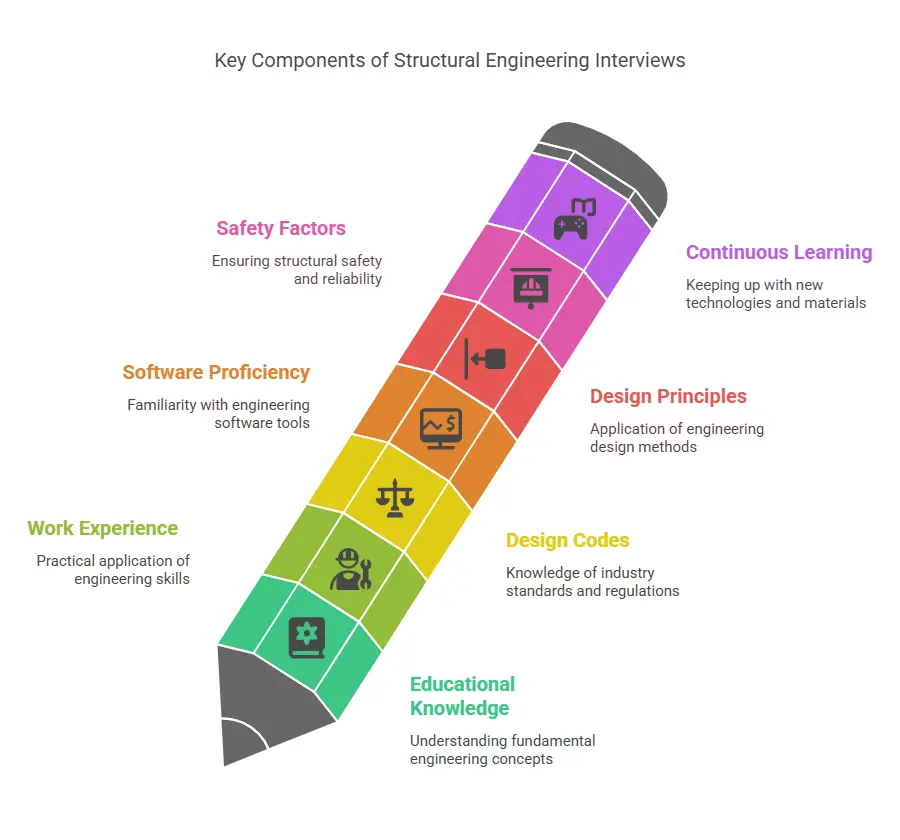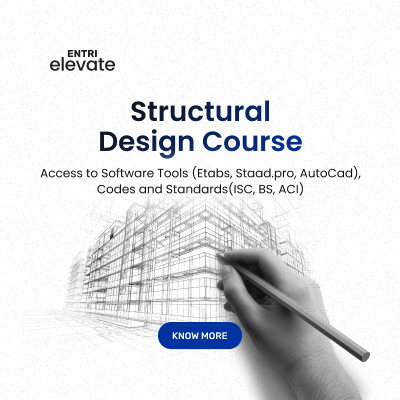Table of Contents
Structural engineering is a vital branch of civil engineering concerned with the analysis, design, and construction of structures to support or withstand loads. As a fresher seeking your initial employment or a veteran looking forward to a new career, structural engineering interviews need both technical knowledge and real-world awareness. In this article, we’ve listed the latest structural engineering interview questions and answers to assist you in preparing confidently. We’ve chosen the questions carefully based on real-life interview trends, including basics as well as latest practices.
Structural Engineering Interview Questions And Answers
Below given are some of the latest and updated structural engineering interview questions and answers.
What is ‘structural analysis’?
Structural analysis is a method of finding forces, moments, and stresses in members of a structure due to loads applied. It provides strength and stability to the structure.
Why is the L/D ratio so important in structural design?
Length-to-Depth ratio (L/D) governs deflection. In beams, it provides them with an assurance that they will not deflect too much when loaded.
What is a simply supported beam?
A beam supported at both ends with no fixed moment connection. It shares load to the supports through reactions.
What is the minimum grade of concrete used in RCC works?
According to IS 456:2000, the minimum grade of concrete used in RCC for general construction is M20.
What are the structural engineering software tools used?
ETABS – Design of multi-story buildings, STAAD.Pro – Structural analysis, AutoCAD – Drafting, SAP2000, SAFE, Revit, etc.
What is done in earthquake-resisting construction?
Provide ductile detailing, Apply shear walls and bracing, Follow IS 1893 codes, Keep structure symmetrical.
What are usual modes of failure in a beam?
Bending failure, Shear failure, Deflection over limit and Torsional failure (in some structures)
What is punching shear?
It happens in slabs subject to point loads, like columns, and it makes the slab fail by a punching mode of failure. It is established in flat slab constructions.
What is a moment of inertia, and why is it significant in structural design?
It is a property of a section’s geometry, which determines its resistance to bending. The more moment of inertia, the more bending resistance.
Why are load paths significant in structural design?
A stable load path will mean loads to flow well from the building to the base. Interruptions will cause failure or excessive deflections.
What is “limit state design”?
It is a technique wherein structures are made to achieve ultimate (strength) and serviceability (deflection, crack) conditions, thereby being safe and usable.
What is shrinkage in concrete?
It is concrete shrinkage when it sets and dries out. It can lead to cracking if not regulated.
What is the role of a column in a building?
A column helps in transferring loads in the vertical direction from the beam or slab to the foundation.
What is efflorescence in bricks?
It is a white salt crust on the surface of bricks because of moisture movement.
What are benefits of steel structure compared to concrete?
It takes less time to construct, Has improved strength-to-weight ratio, It is simpler to make changes and Pre-fabrication is possible.
What is fixed support and its behavior?
Fixed support prevents all the translations as well as rotations. It can support the vertical, horizontal loads and moment.
What is prestressed concrete?
It is a concrete in which internal stresses are introduced (using steel tendons) which act against the external loads. This gives load-carrying capacity.
What type of structure is ductility in structures?
It is the capacity of a structure or material to deform without collapse, particularly under earthquakes. It’s vitally important for seismic design.
Why is a plinth beam used?
It links the foundation and superstructure. It transmits load and avoids differential settlement.
Build A Career In Structural Engineering! Get Free Demo Classes!!
Conclusion
1: What is the primary purpose of structural design?
Structural interview questions not only evaluate your educational knowledge, but also working experience and expertise of design codes and software. The above questions are some of the most common questions asked in 2024–2025 interviews and are designed to test your foundation and preparation for actual projects. Emphasize principles such as load paths, behavior of members, design principles, and safety factors. Continue learning new materials, new construction technologies, and software packages. Both technical expertise and exposure to the site are your best bets to crack any structural engineering interview.
Transform Your Career with Our Structural Design Course!
Unlock Your Potential in Structural Design! Gain expert knowledge in designing robust structures and advance your career in the construction and engineering fields. Limited spots available! 🌟
Know MoreFrequently Asked Questions
What does a structural engineer do?
A structural engineer designs, analyzes, and ensures the safety and stability of buildings, bridges, and other infrastructure by calculating loads, stresses, and material strength.
What is the role of a foundation in a structure?
The foundation transfers structural loads safely to the ground, ensuring stability and preventing settlement.
What is the most important responsibility of a structural engineer?
To make sure that a building or structure is safe, stable, and strong enough to carry all the loads it will face during its life.
What made you choose structural engineering as your career?
Structural engineering lets me be part of creating safe, strong, and useful structures.
Can you explain what a beam and a column are in simple terms?
A beam is like a strong horizontal stick that holds up floors or roofs. A column is a vertical support that carries weight from the top to the bottom (like legs of a table).














